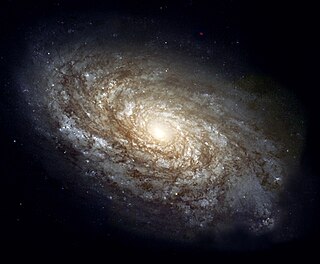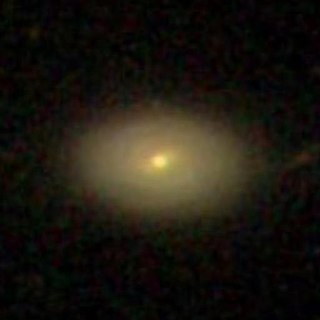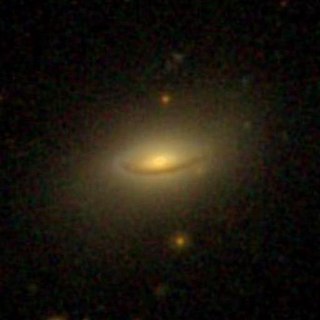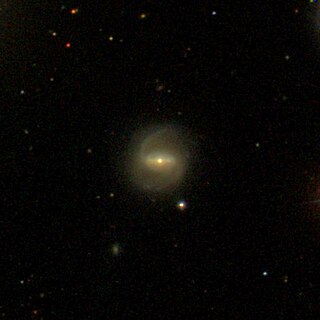
The Leo Cluster is a galaxy cluster about 330 million light-years distant in the constellation Leo, with at least 70 major galaxies. The galaxy known as NGC 3842 is the brightest member of this cluster. Along with the Coma Cluster, it is one of the two major clusters comprising the Coma Supercluster, which in turn is part of the CfA2 Great Wall, which is hundreds of millions light years long and is one of the largest known structures in the universe.

NGC 3862 is an elliptical galaxy located 300 million light-years away in the constellation Leo. Discovered by astronomer William Herschel on April 27, 1785, NGC 3862 is an outlying member of the Leo Cluster.

NGC 4242 is a spiral galaxy in the northern constellation of Canes Venatici. The galaxy is about 18 million light years away. It was discovered on 10 April 1788 by William Herschel, and it was described as "very faint, considerably large, irregular, round, very gradually brighter in the middle, resolvable" by John Louis Emil Dreyer, the compiler of the New General Catalogue.

The Coma I Group is a group of galaxies located about 14.5 Mpc (47.3 Mly) away in the constellation Coma Berenices. The brightest member of the group is NGC 4725. The Coma I Group is rich in spiral galaxies while containing few elliptical and lenticular galaxies. Coma I lies in the foreground of the more distant Coma and Leo clusters and is located within the Virgo Supercluster.

NGC 3860 is a spiral galaxy located about 340 million light-years away in the constellation Leo. NGC 3860 was discovered by astronomer William Herschel on April 27, 1785. The galaxy is a member of the Leo Cluster and is a low-luminosity AGN (LLAGN). Gavazzi et al. however classified NGC 3860 as a strong AGN which may have been triggered by a supermassive black hole in the center of the galaxy.

NGC 4060 is a lenticular galaxy located 320 million light-years away in the constellation Coma Berenices. It was discovered by astronomer Albert Marth on March 18, 1865 and is a member of the NGC 4065 Group which is part of the Coma Supercluster.

NGC 4061 is an elliptical galaxy located 310 light-years away in the constellation Coma Berenices. It was discovered by astronomer William Herschel on April 27, 1785. It was rediscovered by John Herschel on April 29, 1832. It is listed both as NGC 4061 and NGC 4055. NGC 4061 is a member of the NGC 4065 Group and forms an interacting pair with its companion, NGC 4065 as evidenced by distortions in their optical isophotes.

NGC 4066 is an elliptical galaxy located 340 million light-years away in the constellation Coma Berenices. The galaxy was discovered by astronomer William Herschel on April 27, 1785. NGC 4066 is a member of the NGC 4065 Group.

NGC 4074 is a peculiar lenticular galaxy located 310 million light-years away in the constellation Coma Berenices. It was discovered by astronomer William Herschel on April 27, 1785 and is a member of the NGC 4065 Group.

NGC 4076 is a spiral galaxy located 290 million light-years away in the constellation Coma Berenices. The galaxy was discovered by astronomer William Herschel on April 27, 1785 and is a member of the NGC 4065 Group.

The NGC 4065 Group is a group of galaxies located about 330 Mly (100 Mpc) in the constellation Coma Berenices. The group's brightest member is NGC 4065 and located in the Coma Supercluster.

NGC 4298 is a flocculent spiral galaxy located about 53 million light-years away in the constellation Coma Berenices. The galaxy was discovered by astronomer William Herschel on April 8, 1784 and is a member of the Virgo Cluster.

NGC 4324 is a lenticular galaxy located about 85 million light-years away in the constellation Virgo. It was discovered by astronomer Heinrich d'Arrest on March 4, 1862. NGC 4324 has a stellar mass of 5.62 × 1010M☉, and a baryonic mass of 5.88 × 1010M☉. The galaxy's total mass is around 5.25 × 1011M☉. NGC 4324 is notable for having a ring of star formation surrounding its nucleus. It was considered a member of the Virgo II Groups until 1999, when its distance was recalculated and it was placed in the Virgo W Group.

NGC 4333 is a barred spiral galaxy with a ring structure located about 330 million light-years away in the constellation Virgo. It was discovered by astronomer William Herschel on April 13, 1784, who described it as "F, pS, R, bM, 2nd of 3". NGC 4333 is also classified as a LINER galaxy. Despite being listed in the Virgo Cluster catalog as VCC 637, it is not a member of the Virgo Cluster but instead a background galaxy.

IC 4516 is a type E elliptical galaxy located in Boötes. Its redshift is 0.045618 which corresponds IC 4516 to be located 667 million light-years from Earth. The galaxy was discovered by Lewis Swift on June 2, 1898, which was his last discovery after spending half a century observing astronomical objects, starting with the observation of the Great Comet in 1843.

IC 3078 is a spiral galaxy with a ring structure located in Virgo. Its redshift is 0.066148, meaning IC 3078 is located 905 million light-years from Earth. With an apparent dimension of 0.50 x 0.5 arcmin, IC 3038 is about 133,000 light-years across. It was discovered by Royal Harwood Frost on May 7, 1904 and is listed in the Virgo Cluster catalogue as VCC 174. However, it is not a member of the Virgo Cluster, but instead a background galaxy.

OGC 94, also known as PGC 1866064, is a supergiant elliptical galaxy residing as the brightest cluster galaxy in the ZwCI 1305.4+2941 galaxy cluster. It lies in the constellation of Coma Berenices and has a redshift of 0.240, estimating the galaxy to be located 3.3 billion light-years away from Earth.

Abell 1576 BCG also known as PGC 2651193, is a supergiant elliptical galaxy and is the brightest cluster galaxy in Abell 1576, located in the constellation of Ursa Major. At a redshift of 0.300, the galaxy is about 3.8 billion light-years away from Earth.

Abell 68 is massive and rich galaxy cluster located in the constellation of Pisces with a projected co-moving distance of approximately 1124.6 Mpc or 3.668 billion light-years away from Earth. The cluster is especially notable for its gravitational lensing and was first discovered by George O. Abell in 1958.

RIQ J1336+1725 also known as PB 4007 and PG 1333+177, is a quasar located in the constellation of Coma Berenices. At a low redshift of 0.55, the object is located 6.5 billion light-years from Earth. This quasar is known to have a Lyman edge region that is formed by its thermally emitting accretion disk.




















